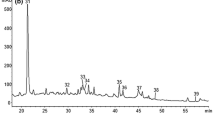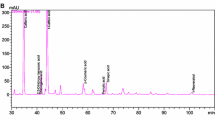Abstract
A hundred and thirty-six single-cultivar red wines of different vintages were collected from several wineries in the Canary Islands in order to study the magnitude of the copigmentation phenomenon and the antioxidant activity. The contribution of free anthocyanins, copigmented anthocyanins and polymeric pigments to the colour of wine, as well as the total phenols, the antioxidant activity (2,2-diphenyl-1-picrylhydrazyl, DPPH method) and the chromatic characteristics of the wines were determined. The influence of ageing time and the climatic conditions on these parameters was also studied. The wines made with Merlot, Ruby Cabernet and Syrah cultivars showed the highest parameters of colour, and the largest contribution to the copigmented anthocyanins was from the Ruby Cabernet, Listán negro and Syrah cultivars. The copigmented anthocyanins and the free anthocyanins decrease with the age of the wine, and the antioxidant activity of the samples appears to be related to the total phenol content. An influence of the climatic conditions on colour parameters has been found. The correlation study between parameters suggests that the parameters b* and L* could be used as suitable indicators of evolution or oxidation stage of red wines.
Similar content being viewed by others
References
Parpinello GP, Versari A, Chinnici F, Galassi S (2009) A relationship among sensory descriptors, consumer preference and color parameters of Italian Novello red wines. Food Res Int 42:1389–1395
Gil-Muñoz R, Gómez-Plaza E, Martínez A, López-Roca JM (1997) Evolution of the CIELAB and other spectrophotometric parameters during wine fermentation. Influence of some pre and postfermentative factors. Food Res Int 30:699–705
Martínez-Pinilla O, Martínez-Lapuente L, Guadalupe Z, Ayestarán B (2012) Sensory profiling and changes in color and phenolic composition produced by malolactic fermentation in red minority varieties. Food Res Int 46:286–293
O. I. V. (2006) Determination of chromatic characteristics according to CIELab. Resolution Oeno 1/2006. In: Compendium of international analysis of methods—OIV: chromatic characteristics
Boulton R (2001) The copigmentation of anthocyanins and its role in the color of red wine: a critical review. Am J Enol Vitic 52(2):67–87
Markovic JM, Petranovic NA, Baranac JM (2000) A spectrophotometric study of the copigmentation of malvin with caffeic and ferulic acids. J Agric Food Chem 48:5530–5536
Bakowska AB, Kucharska AZ, Oszmianski J (2003) The effects of heating, UV irradiation, and storage on stability of the anthocyanin–polyphenol copigment complex. Food Chem 81:349–355
Rustioni L, Bedgood DR, Failla O, Prenzler PD, Robards K (2012) Copigmentation and anti-copigmentation in grape extracts studied by spectrophotometry and post-column reaction HPLC. Food Chem 132:2194–2201
Cozzolino D, Cynkar WU, Shah N, Smith P (2011) Can spectroscopy geographically classify Sauvignon Blanc wines from Australia and New Zealand? Food Chem 126:673–678
Jaitz L, Siegl K, Eder R, Rak G, Abranko L, Koellensperger G, Hann S (2010) LC–MS/MS analysis of phenols for classification of red wine according to geographic origin, grape variety and vintage. Food Chem 122:366–372
Pérez-Lamela C, García-Falcón MS, Simal-Gándara J, Orriols-Fernández I (2007) Influence of grape variety, vine system and enological treatments on the colour stability of young red wines. Food Chem 101:601–606
Kunsági-Máté S, Ortmann E, Kollár L, Szabó K, Nikfardjam M (2008) Effect of ferrous and ferric ions on copigmentation in model solutions. J Mol Struct 811:471–474
Czibulya Z, Horváth I, Kollár L, Kunsági-Máté S (2012) Unexpected effect of potassium ions on the copigmentation in red wines. Food Res Int 45:272–276
Darías-Martín J, Carrillo M, Díaz E, Boulton R (2001) Enhancement of red wine color by pre-fermentative addition of copigment precursors. Food Chem 73:217–220
Darías-Martín J, Martín-Luis B, Carrillo-López M, Lamuela-Raventós R, Díaz-Romero C, Boulton R (2002) Effect of caffeic acid on the color of red wine. J Agric Food Chem 50:2062–2067
Darias-Martín J, Carrillo-López M, Echavarri-Granado JF, Díaz-Romero C (2007) The magnitude of copigmentation in the colour of aged red wines made in the Canary Islands. Eur Food Res Technol 224:643–648
Hermosin-Gutiérrez I, Sánchez-Palomo E, Vicario-Espinosa A (2005) Phenolic composition and magnitude of copigmentation in young and shortly aged red wines made from the cultivars, Cabernet Sauvignon, Cencibel, and Syrah. Food Chem 92:269–283
Boulton RB (1996) A method for the assessment of copigmentation in red wines. Presented at the 47th annual meeting of the American Society for Enology and Viticulture, Reno
Gómez-Míguez M, González-Manzano S, Escribano-Bailón M, Heredia FJ, Santos-Buelga C (2006) Influence of different phenolic copigments on the color of malvidin-3-glucoside. J Agric Food Chem 54:5422–5429
MAPA. (1994) Métodos Oficiales de Análisis. Tomo II 39-319. Madrid
O.I.V. (2009) Compendium of international methods of analysis: AS311-02, AS313-07 and AS313-11
Somers TC, Evans ME (1977) Spectral evaluation of young red wines: anthocyanin equilibria, total phenolic, free and molecular SO2, “chemical age”. J Sci Food Agric 28:279–287
CIE (2004) Colorimetry. In: Publications CIE. Commission Internationale de l’Eclairage Central Bureau, Technical Report, Vienna (Austria), CIE: 15.2
Brand-Williams W, Cuvelier ME, Berset C (1995) Use of a free radical method to evaluate antioxidant activity. Food Sci Technol-Leb 28:25–30
Rivero-Pérez MD, Muñiz P, González-Sanjosé ML (2007) Antioxidant profile of red wines evaluated by total antioxidant capacity, scavenger activity, and biomarkers of oxidative stress methodologies. J Agric Food Chem 55:5476–5483
Escudero-Gilete ML, González-Miret ML, Heredia FJ (2010) Implications of blending wines on the relationships between the colour and the anthocyanic composition. Food Res Int 43:745–752
Díaz C, Conde JE, Claverie C, Díaz E, Pérez-Trujillo JP (2003) Conventional enological parameters of bottled wines from the Canary Islands (Spain). J Food Compos Anal 16(1):49–56
Flanzy C (2000) Enología: Fundamentos científicos y tecnológicos. Ediciones Mundi-Prensa y A. Madrid Vicente Ediciones, Madrid
Iñiguez M, Rosales A, Ayala R, Puras P, Ortega AP, Ortiz MC, Herrero A, Sánchez MS, Sarabia LA (1995). La cata de color y los parámetros Cielab, caso de los vinos tintos de “Rioja”. In: Proceedings OIV. XXI world congress of vine and wine. Punta del Este, Uruguay. ROU 392–411
Ortega AP, García M E, Hidalgo J, Tienda P, Serrano J (1995) Identificacion y Normalizacion de los colores del vino. Carta de colores. In: Proceedings OIV. XXI world congress of vine and wine., Punta del Este. ROU 378–391
Gómez-Gallego MA, Gómez-García E, Sánchez-Palomo E, González-Viñas MA, Hermosín-Gutiérrez I (2012) Effect of co-winemaking in phenolic composition, color and antioxidant capacity of young red wines from la Mancha region. Eur Food Res Technol 235:155–167
Mulero J, Pardo F, Zafrilla P (2010) Antioxidant activity and phenolic composition of organic and conventional grapes and wines. J Food Compos Anal 23:569–574
Bukman L, Campos-Martins A, Oliveira-Barizao E, Vergilio-Visentainer J, Cinque-Almeida V (2013) DPPH assay adapted to the FIA system for the determination of the antioxidant capacity of wines: optimization of the conditions using the response surface methodology. Food Anal Methods 6:1424–1432
Beer D, Joubert E, Gelderblom W, Manley M (2003) Antioxidant activity of South African red and white cultivar wines: free radical scavenging. J Agric Food Chem 51:902–909
Zafrilla P, Morillas J, Mulero J, Cayuela J, Martinez-Cacha A, Pardo F, López-Nicolás JM (2003) Changes during storage in conventional and ecological wine: phenolic content and antioxidant activity. J Agric Food Chem 51:4694–4700
Sánchez-Montero C, Larrauri JA, Saura-Calixto F (1999) Free radical scavenging capacity of selected red, rosé and white wines. J Sci Food Agric 79:1301–1304
Lucena APS, Nascimento RJB, Maciel JAC, Tavares JX, Barbosa-Filho JM, Oliveira EJ (2010) Antioxidant activity and phenolics content of selected Brazilian wines. J Food Compos Anal 23:30–36
Fernández-Pachón MS, Villaño D, García-Parrilla MC, Troncoso AM (2004) Antioxidant activity of wines and relation with their polyphenolic composition. Anal Chim Acta 513:113–118
Conflict of interest
None.
Compliance with Ethics Requirements
This article does not contain any studies with human or animal subjects.
Author information
Authors and Affiliations
Corresponding author
Rights and permissions
About this article
Cite this article
Heras-Roger, J., Pomposo-Medina, M., Díaz-Romero, C. et al. Copigmentation, colour and antioxidant activity of single-cultivar red wines. Eur Food Res Technol 239, 13–19 (2014). https://doi.org/10.1007/s00217-014-2185-0
Received:
Revised:
Accepted:
Published:
Issue Date:
DOI: https://doi.org/10.1007/s00217-014-2185-0




